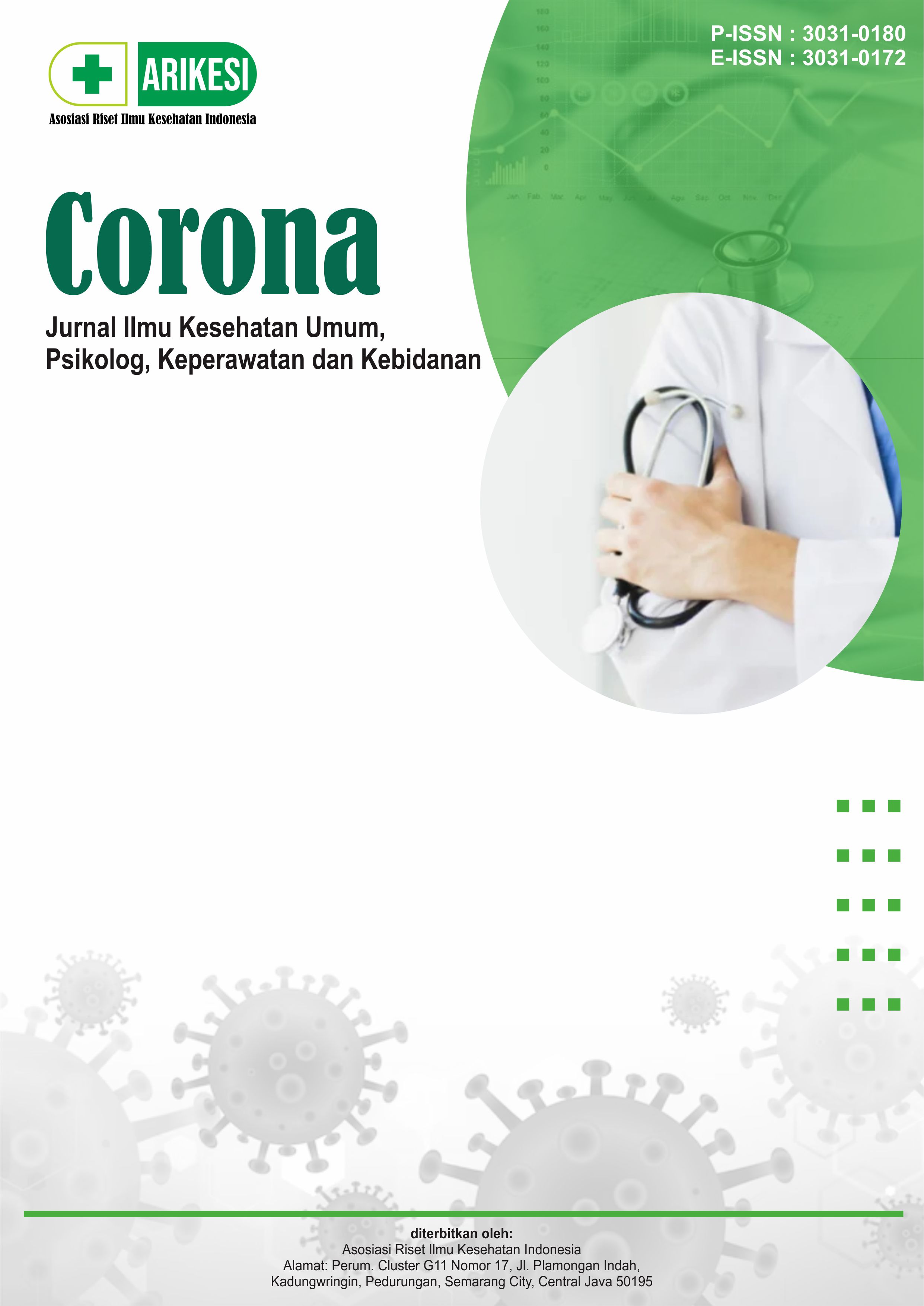Perbedaan Optimisme Pada Siswa SMA NU 2 Gresik Ditinjau Dari Jenis Kelamin
DOI:
https://doi.org/10.61132/corona.v3i2.1292Keywords:
Optimism, gender, differenceAbstract
Idayatul Khasanah (190701009). Differences in Optimism in Students of SMA NU 2 Gresik Reviewed by Gender. This study aims to determine the Differences in Optimism in Students of SMA NU 2 Gresik Reviewed from Gender. This study uses a quantitative approach, with a comparative method. Respondents in this study were students of SMA NU 2 Gresik. The sampling technique with nonprobability sampling using accidental sampling technique. A total of 110 respondents. The scale validity test uses content validity. Reliability test uses Alpha Cornbach. This study uses an optimism scale with a reliability of 0,885. Data analysis uses a different test, namely the independent sample t-test. The results of the hypothesis test show that the hypothesis of this study (Hₐ) is rejected because the Sig. (2-tailed) value is 0.076> 0.05. So, there is no significant difference in optimism in gender. The unproven hypothesis in this study can be caused by various factors that influence students' overall optimism. These factors include socio-economic conditions, the culture that applies in the student's environment, the area of residence (village or city), and social interaction patterns that are formed in schools and families.
Downloads
References
Abdullahi, I. A., & Kumar, P. (2016). Gender differences in prosocial behaviour. The International Journal of Indian Psychology, 3(4), 171–175.
Adhandayani, & Ediati. (2015). Pengalaman proses coming out transgender pada keluarga dan lingkungan. Jurnal Empati, 4(4), 277–281. http://media.neliti.com
Amin, M. S. (2018). Perbedaan struktur otak dan perilaku belajar antara pria dan wanita; eksplanasi dalam sudut pandang neuron sains dan filsafat. Jurnal Filsafat Indonesia, 1(1), 38–43.
Annafi, M., & Liftia. (2012). Optimisme untuk sembuh penyalahgunaan Napza (studi deskriptif di Pusat Rehabilitasi Rumah Damai Semarang). Jurnal Psikologi Ilmiah, 4(1), 1–6.
Azwar, S. (2015). Metode penelitian. Yogyakarta: Pustaka Pelajar.
Azwar, S. (2017). Metode penelitian psikologi. Yogyakarta: Pustaka Pelajar.
Diener, E., & Seligman, M. E. P. (2004). Beyond money: Toward an economy of well-being. Psychological Science in the Public Interest, 5(1), 1–31. https://doi.org/10.1111/j.0963-7214.2004.00501001.x
Feinman, S., & Gill, G. W. (1978). Sex differences in physical attractiveness preferences. The Journal of Social Psychology, 105(1), 43–52.
Ghufron, M. N., & Rini, R. S. (2010). Teori-teori psikologi. Yogyakarta: Ar Ruzz Media.
Goleman, D. (2004). Kecerdasan emosional: Mengapa EI lebih penting daripada IQ (T. Hermaya, Trans.). Jakarta: PT. Gramedia Pustaka Utama.
Goleman, D. (2007). Kecerdasan emosional. Jakarta: PT. Gramedia Pustaka Utama.
Hurlock, E. B. (1991). Psikologi perkembangan: Suatu pendekatan sepanjang rentang kehidupan. Jakarta: Erlangga.
Istiana, I. (2018). Perbedaan perilaku prososial remaja ditinjau dari jenis kelamin di Kelurahan Tanjung Rejo Medan Sunggal. Jurnal Diversita, 4(1), 58–67.
Kerley, D. C. (2006). Optimism. Retrieved from http://www.dr.kerley.com/file/newsletter/052.pdf
Kusumaningrum, E., & Dewi, N. K. (2017). Perbedaan perilaku prososial dan self-awareness terhadap nilai budaya lokal Jawa ditinjau dari jenis kelamin pada siswa SMA Kyai Ageng Basyariyah Kecamatan Dagangan Kabupaten Madiun. Counsellia: Jurnal Bimbingan dan Konseling, 6(2), 17–30.
Lai, J., Ma, S., Wang, Y., Cai, Z., Hu, J., Wei, N., ... Hu, S. (2020). Factors associated with mental health outcomes among health care workers exposed to coronavirus disease 2019. JAMA Network Open, 3(3), 1–12. https://doi.org/10.1001/jamanetworkopen.2020.3976
Lopez, S. J., & Snyder, C. R. (2003). Positive psychological assessment: A handbook of models and measures. Washington, DC: APA.
Ningrum, Y. (2011). Upaya meningkatkan kemampuan membaca permulaan anak melalui media pancing pintar kelompok B TK Pertiwi 02 Gantiwarno Matesih Karanganyar (Skripsi, Universitas Muhammadiyah Surakarta).
Nurtjahjanti, H., & Rahayu, I. Z. (n.d.). Hubungan kepribadian hardiness dengan optimisme pada calon tenaga kerja Indonesia (CTKI) wanita di BLKLN Disnakertrans Jawa Tengah. Jurnal Psikologi, 2(10), 126–132. https://doi.org/10.14710/jpu.10.2.126-132
Sandu, S., & Sodik, M. A. (2015). Dasar metodologi penelitian (Edisi kesatu). Literasi Media.
Santrock, J. W. (2003). Adolescence: Perkembangan remaja (Edisi Keenam). Jakarta: Erlangga.
Scheier, M. F., Weintraub, J. K., & Carver, C. S. (1986). Coping with stress: Divergent strategies of optimism and pessimists. Journal of Personality and Social Psychology, 51, 1257–1264.
Schleimer, R. P., et al. (n.d.). The role of adhesion molecules and cytokines in eosinophils recruitment. In Gleich & Kay (Eds.), Eosinophils in allergy and inflammation.
Seligman, M. E. (1995). The optimistic child. Boston-New York: Houghton Mifflin Company.
Seligman, M. E. (1998). Learned optimism. New York: Pocket Books.
Seligman, M. E. (2006). Learned optimism: How to change your mind and your life. New York: Vintage Books.
Seligman, M. E. (2008). Menginstal optimisme. Bandung: Momentum.
Sharot, T. (2011). The optimism bias. Current Biology, 21(23), R941–R945. https://doi.org/10.1016/j.cub.2011.10.030
Snyder, C. R. (2000). Handbook of hope: Theory, measures, and applications. San Diego, CA: Academic Press.
Snyder, C. R. (2002). Hope theory: Rainbows in the mind. Psychological Inquiry, 13(4), 249–275. https://doi.org/10.1207/S15327965PLI1304_01
Snyder, C. R., Harris, C., Anderson, J. R., Holleran, S. A., Irving, L. M., Sigmon, S. T., et al. (2005). The will and the ways: Development and validation of an individual-differences measure of hope. Journal of Personality and Social Psychology, 60, 570–585.
Sugiyono. (2016). Metode penelitian kuantitatif kualitatif dan R&D. Bandung: Alfabeta.
Sugiyono. (2017). Metode penelitian kuantitatif, kualitatif, dan R&D. Bandung: Alfabeta.
Sugiyono. (2019). Metode penelitian kuantitatif, kualitatif, dan R&D. Bandung: Alfabeta.
Suhardin, S. (2016). Pengaruh perbedaan jenis kelamin dan pengetahuan tentang konsep dasar ekologi terhadap kepedulian lingkungan. EDUKASI: Jurnal Penelitian Pendidikan Agama dan Keagamaan, 14(1), 117–132.
Wardhaugh, R. (2006). An introduction to sociolinguistics (5th ed.). UK: Blackwell Publishing.
Downloads
Published
How to Cite
Issue
Section
License
Copyright (c) 2025 Corona: Jurnal Ilmu Kesehatan Umum, Psikolog, Keperawatan dan Kebidanan

This work is licensed under a Creative Commons Attribution-ShareAlike 4.0 International License.





